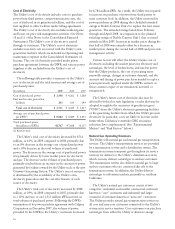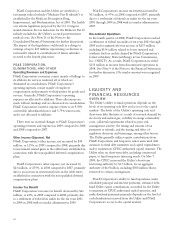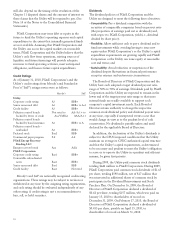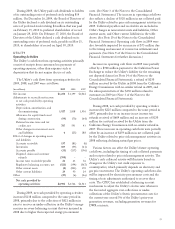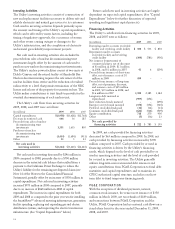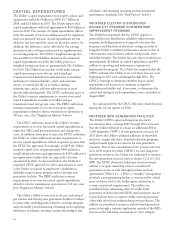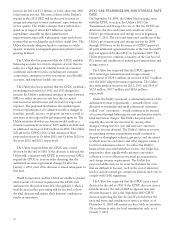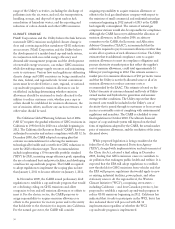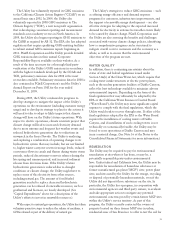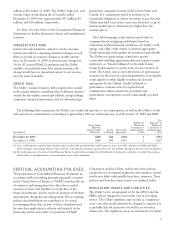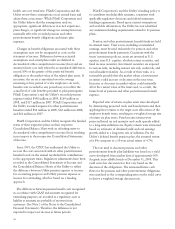PG&E 2009 Annual Report Download - page 30
Download and view the complete annual report
Please find page 30 of the 2009 PG&E annual report below. You can navigate through the pages in the report by either clicking on the pages listed below, or by using the keyword search tool below to find specific information within the annual report.CAPITAL EXPENDITURES
The Utility’s capital expenditures for property, plant, and
equipment totaled $3.9 billion in 2009, $3.7 billion in
2008, and $2.8 billion in 2007. The Utility expects that
capital expenditures will total approximately $4.0 billion or
more in 2010. The amount of capital expenditures differs
from the amount of rate base additions used for regulatory
purposes primarily because capital expenditures are not
added to rate base until the assets are placed in service. In
addition, the difference can be affected by the varying
amounts or rates of depreciation used for regulatory and
accounting purposes. The Utility’s weighted average rate
base in 2009 was $19.8 billion. Based on the estimated
capital expenditures for 2010, the Utility projects a
weighted average rate base of approximately $21.4 billion
for 2010. The Utility forecasts that it will make various
capital investments in its electric and natural gas
transmission and distribution infrastructure to maintain
and improve system reliability, safety, and customer
service; to extend the life of or replace existing
infrastructure; and to add new infrastructure to meet
already authorized growth. The CPUC authorized most of
the Utility’s revenue requirements to recover forecasted
capital expenditures in multi-year GRCs and gas
transmission and storage rate cases. The FERC authorizes
revenue requirements to recover forecasted capital
expenditures related to electric transmission operations in
TO rate cases. (See “Regulatory Matters” below.)
The CPUC authorizes most of the Utility’s revenue
requirements to recover forecasted capital expenditures in
multi-year GRCs and gas transmission and storage rate
cases. In addition, from time to time, the CPUC authorizes
the Utility to collect additional revenue requirements to
recover capital expenditures related to specific projects that
the CPUC has approved. For example, in 2009 the Utility
incurred capital costs of approximately $490 million to
install advanced meters and approximately $350 million for
new generation facilities that are expected to become
operational in 2010. As discussed below, the Utility has
requested CPUC approval for other capital projects, such
as the Utility’s proposal to implement a distribution
reliability improvement program and to develop new
generation facilities. The FERC authorizes revenue
requirements to recover forecasted capital expenditures
related to electric transmission operations in TO rate cases.
(See “Regulatory Matters” below.)
The Utility’s ability to invest in its electric and natural
gas systems and develop new generation facilities is subject
to many risks, including risks related to securing adequate
and reasonably priced financing, obtaining and complying
with terms of permits, meeting construction budgets and
schedules, and satisfying operating and environmental
performance standards. (See “Risk Factors” below.)
PROPOSED ELECTRIC DISTRIBUTION
RELIABILITY PROGRAM (CORNERSTONE
IMPROVEMENT PROGRAM)
The Utility has requested that the CPUC approve a
proposed electric distribution reliability improvement
program, including initiatives designed to decrease the
frequency and duration of electricity outages in order to
bring the Utility’s reliability performance closer to that of
other investor-owned electric utilities and provide other
reliability benefits. The Utility forecasts that it would incur
approximately $2 billion of capital expenditures and $59
million of operating and maintenance expenses to
implement the program. The Utility has requested that the
CPUC authorize the Utility to recover these forecast costs
beginning in 2011 and continuing through 2016. The
CPUC’s hearings to determine whether major capital
expenditures are necessary to maintain or improve
distribution reliability and, if necessary, to determine the
extent and timing of such expenditures, were concluded in
August 2009.
It is anticipated that the CPUC will issue a final decision
during the second quarter of 2010.
PROPOSED NEW GENERATION FACILITIES
The Utility’s CPUC-approved long-term electricity
procurement plan, covering 2007 through 2016, forecasts
that the Utility will need to obtain an additional 800 to
1,200 megawatts (“MW”) of new generation resources by
2015 above the Utility’s planned additions of renewable
resources, energy efficiency, demand reduction programs,
and previously approved contracts for new generation
resources. Due to the cancellation of two projects selected
in its 2004 request for offers (“RFOs”) for new long-term
generation resources, the Utility was authorized to increase
the new generation resource need to obtain 1,112 to 1,512
MW. The CPUC allows the California investor-owned
utilities to acquire ownership of new conventional
generation resources only through purchase and sale
agreements (“PSAs”) (i.e., a PSA is a “turnkey” arrangement
in which a new generating facility is constructed by a third
party and then sold to the Utility upon satisfaction of
certain contractual requirements). The utilities are
prohibited from submitting offers for utility-built
generation in their respective RFOs until questions can be
resolved about how to compare utility-owned generation
offers with offers from independent power producers. The
utilities are permitted to propose utility-owned generation
projects through a separate application outside of the RFO
process in the following circumstances: (1) to mitigate
26


